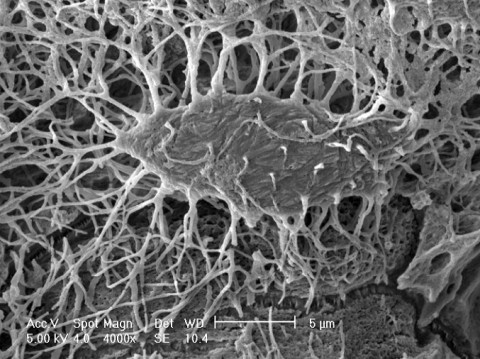Written by Laura Niles
International Space Station Program Science Office and Public Affairs Office
NASA Johnson Space Center
 Houston, TX – Researchers may be “excyted” to learn that osteocyte cultures are headed to the International Space Station this spring for the first time. With their delivery on the next SpaceX commercial resupply services mission this month, the Osteocytes and mechano-transduction (Osteo-4) investigation team will analyze the effects of microgravity on this type of bone cell.
Houston, TX – Researchers may be “excyted” to learn that osteocyte cultures are headed to the International Space Station this spring for the first time. With their delivery on the next SpaceX commercial resupply services mission this month, the Osteocytes and mechano-transduction (Osteo-4) investigation team will analyze the effects of microgravity on this type of bone cell.
Understanding these effects will be critical as astronauts plan for future missions that require longer exposure to microgravity, such as to deep space or Mars.

“We are investigating how osteocytes – the most abundant cells in the adult skeleton – both sense and respond to changes in mechanical forces, as achieved aboard the space station,” said National Institutes of Health (NIH) grantee Paola Divieti Pajevic, M.D., Ph.D., principal investigator of the Osteo-4 study and associate professor at the Goldman School of Dental Medicine at Boston University.
Through previous spaceflight studies, some crew members have shown a loss of bone mass after long-duration missions in space. Divieti Pajevic’s team examines the function and behavior of isolated osteocytes in microgravity to determine how they may contribute to the observed decline in crew member bone density.
Osteocytes are the cells that sense mechanical forces, like weight-lifting, as they are applied to the skeleton. They transform these forces into biological responses, signaling other cells to make or remove bone.
“If we can figure out bone loss in the extreme conditions of space, we could figure out how to make more bone or counteract bone loss in astronauts,” said Divieti Pajevic. “This has applications to millions of people on Earth who are affected by osteoporosis and related fractures.”
Divieti Pajevic’s research team uses samples from a specific line of bone cells from mice that mimic human bone osteocytes in gene expression. Gene expression is the process in which information programmed in a gene is used to direct the assembly of a protein molecule, which then helps carry out the instructions given to the cell for its role. The team will try to isolate the genetic signals changed in the cells once exposed to microgravity.
During the Osteo-4 study, the osteocytes are grown in a synthetic, tissue-like, three-dimensional structure and housed inside bioreactors. Bioreactors are containers used to allow the cells to grow in a protected environment. Three trays each house three individual bioreactors, creating a total of nine samples for study on the space station.
The Osteo-4 study, sponsored by the NIH’s National Institute of Arthritis and Musculoskeletal and Skin Diseases, the Center for the Advancement of Science in Space and NASA’s Kennedy Space Center, is Divieti Pajevic’s first space station investigation. The project is funded under the Biomedical Research on the International Space Station (BioMed-ISS) initiative, a collaborative effort between NIH and NASA.
Osteo-4 also represents the fourth mission for the Osteo series of investigations. Previously known as the Osteoporosis Experiment in Orbit, the research series began as a Canadian Space Agency project on Space Shuttle Discovery in 1998.
“For us, the possibility to use the space station is really important to validate the ground-based model that we use in the lab,” said Divieti Pajevic. “We can envision doing multiple experiments, once we know how the cells behave in microgravity. Then we can try to find different pathways to manipulate the cells.”
With this first osteocyte study in space, scientists may gain a better understanding of these plentiful bone cells’ function. And with the orbiting laboratory planned for operations until at least 2024, this osteocyte project may be the beginning of what’s to come.


